child lock BMW X5 3.0I 2002 Owners Manual
[x] Cancel search | Manufacturer: BMW, Model Year: 2002, Model line: X5 3.0I, Model: BMW X5 3.0I 2002Pages: 185, PDF Size: 2.7 MB
Page 4 of 185
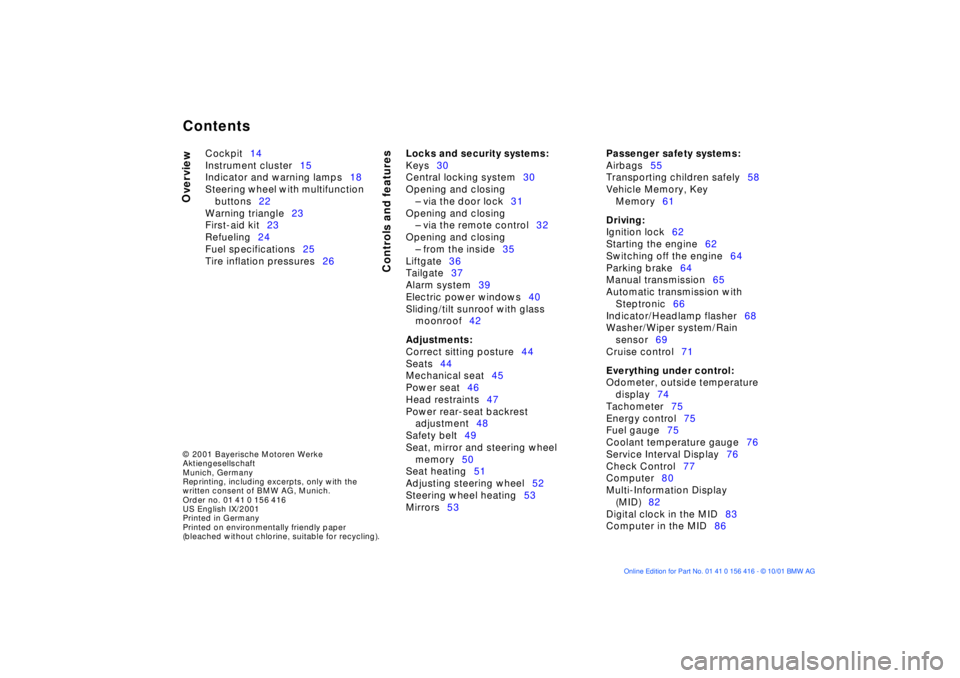
Contents
© 2001 Bayerische Motoren Werke
Aktiengesellschaft
Munich, Germany
Reprinting, including excerpts, only with the
written consent of BMW AG, Munich.
Order no. 01 41 0 156 416
US English IX/2001
Printed in Germany
Printed on environmentally friendly paper
(bleached without chlorine, suitable for recycling).
Overview
Controls and features
Cockpit14
Instrument cluster15
Indicator and warning lamps18
Steering wheel with multifunction
buttons22
Warning triangle23
First-aid kit23
Refueling24
Fuel specifications25
Tire inflation pressures26
Locks and security systems:
Keys30
Central locking system30
Opening and closing
Ð via the door lock31
Opening and closing
Ð via the remote control32
Opening and closing
Ð from the inside35
Liftgate36
Tailgate37
Alarm system39
Electric power windows40
Sliding/tilt sunroof with glass
moonroof42
Adjustments:
Correct sitting posture44
Seats44
Mechanical seat45
Power seat46
Head restraints47
Power rear-seat backrest
adjustment48
Safety belt49
Seat, mirror and steering wheel
memory50
Seat heating51
Adjusting steering wheel52
Steering wheel heating53
Mirrors53
Passenger safety systems:
Airbags55
Transporting children safely58
Vehicle Memory, Key
Memory61
Driving:
Ignition lock62
Starting the engine62
Switching off the engine64
Parking brake64
Manual transmission65
Automatic transmission with
Steptronic66
Indicator/Headlamp flasher68
Washer/Wiper system/Rain
sensor69
Cruise control71
Everything under control:
Odometer, outside temperature
display74
Tachometer75
Energy control75
Fuel gauge75
Coolant temperature gauge76
Service Interval Display76
Check Control77
Computer80
Multi-Information Display
(MID)82
Digital clock in the MID83
Computer in the MID86
Inhalt
Page 32 of 185
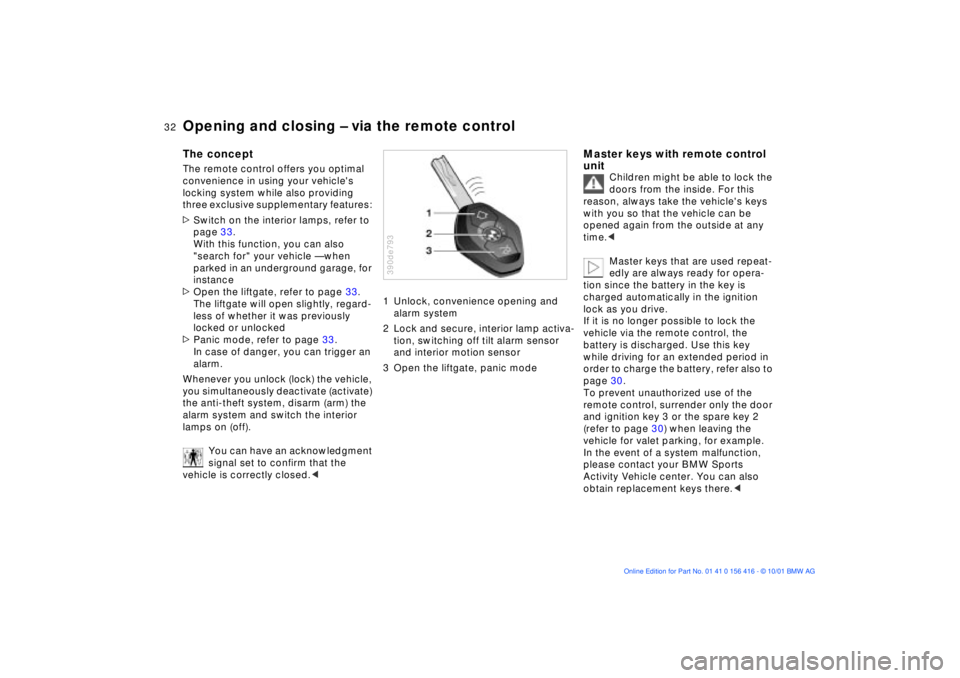
32n
Opening and closing Ð via the remote controlThe conceptThe remote control offers you optimal
convenience in using your vehicle's
locking system while also providing
three exclusive supplementary features:
>Switch on the interior lamps, refer to
page 33.
With this function, you can also
"search for" your vehicle Ñ when
parked in an underground garage, for
instance
>Open the liftgate, refer to page 33.
The liftgate will open slightly, regard-
less of whether it was previously
locked or unlocked
>Panic mode, refer to page 33.
In case of danger, you can trigger an
alarm.
Whenever you unlock (lock) the vehicle,
you simultaneously deactivate (activate)
the anti-theft system, disarm (arm) the
alarm system and switch the interior
lamps on (off).
You can have an acknowledgment
signal set to confirm that the
vehicle is correctly closed.<
1 Unlock, convenience opening and
alarm system
2 Lock and secure, interior lamp activa-
tion, switching off tilt alarm sensor
and interior motion sensor
3 Open the liftgate, panic mode390de793
Master keys with remote control
unit
Children might be able to lock the
doors from the inside. For this
reason, always take the vehicle's keys
with you so that the vehicle can be
opened again from the outside at any
time.<
Master keys that are used repeat-
edly are always ready for opera-
tion since the battery in the key is
charged automatically in the ignition
lock as you drive.
If it is no longer possible to lock the
vehicle via the remote control, the
battery is discharged. Use this key
while driving for an extended period in
order to charge the battery, refer also to
page 30.
To prevent unauthorized use of the
remote control, surrender only the door
and ignition key 3 or the spare key 2
(refer to page 30) when leaving the
vehicle for valet parking, for example.
In the event of a system malfunction,
please contact your BMW Sports
Activity Vehicle center. You can also
obtain replacement keys there.<
Page 40 of 185
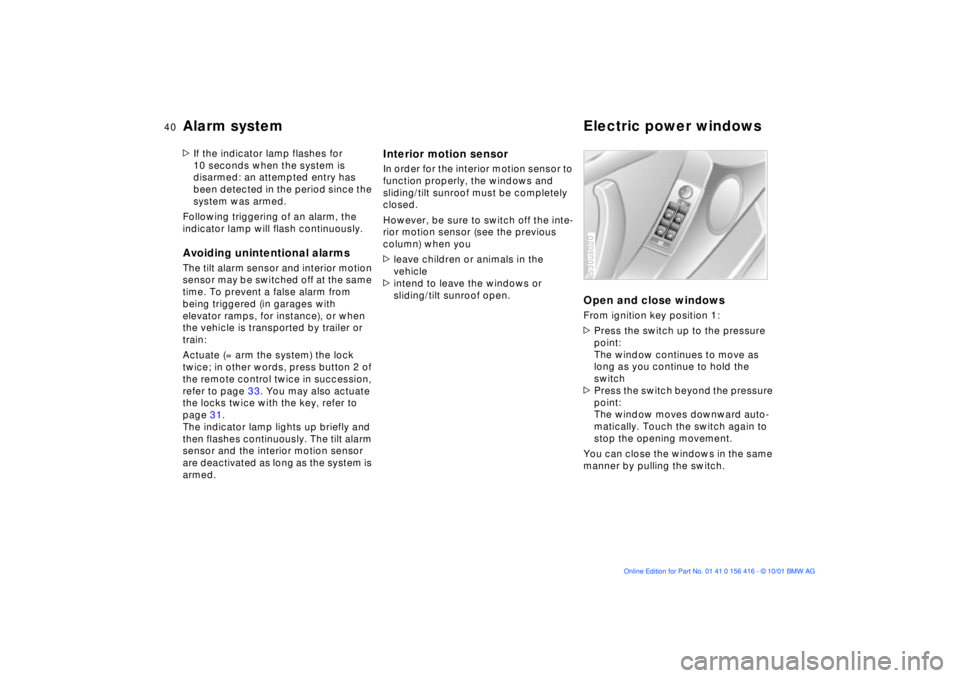
40n
Alarm system Electric power windows >If the indicator lamp flashes for
10 seconds when the system is
disarmed: an attempted entry has
been detected in the period since the
system was armed.
Following triggering of an alarm, the
indicator lamp will flash continuously. Avoiding unintentional alarmsThe tilt alarm sensor and interior motion
sensor may be switched off at the same
time. To prevent a false alarm from
being triggered (in garages with
elevator ramps, for instance), or when
the vehicle is transported by trailer or
train:
Actuate (= arm the system) the lock
twice; in other words, press button 2 of
the remote control twice in succession,
refer to page 33. You may also actuate
the locks twice with the key, refer to
page 31.
The indicator lamp lights up briefly and
then flashes continuously. The tilt alarm
sensor and the interior motion sensor
are deactivated as long as the system is
armed.
Interior motion sensor In order for the interior motion sensor to
function properly, the windows and
sliding/tilt sunroof must be completely
closed.
However, be sure to switch off the inte-
rior motion sensor (see the previous
column) when you
>leave children or animals in the
vehicle
>intend to leave the windows or
sliding/tilt sunroof open.
Open and close windowsFrom ignition key position 1:
>Press the switch up to the pressure
point:
The window continues to move as
long as you continue to hold the
switch
>Press the switch beyond the pressure
point:
The window moves downward auto-
matically. Touch the switch again to
stop the opening movement.
You can close the windows in the same
manner by pulling the switch.530us020
Page 41 of 185
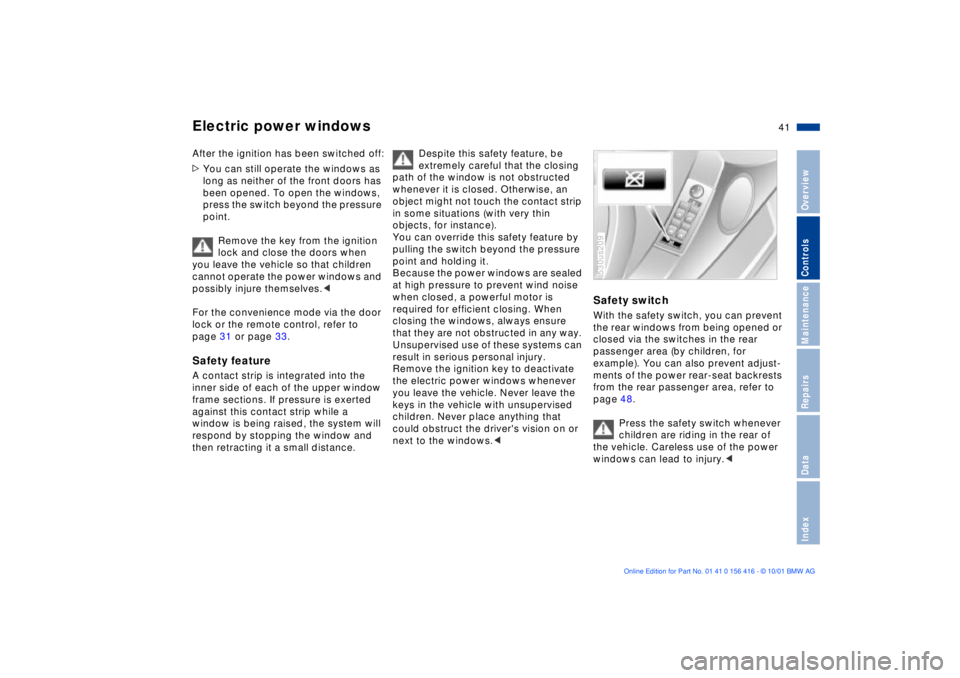
41n
OverviewControlsMaintenanceRepairsDataIndex
Electric power windows After the ignition has been switched off:
>You can still operate the windows as
long as neither of the front doors has
been opened. To open the windows,
press the switch beyond the pressure
point.
Remove the key from the ignition
lock and close the doors when
you leave the vehicle so that children
cannot operate the power windows and
possibly injure themselves.<
For the convenience mode via the door
lock or the remote control, refer to
page 31 or page 33. Safety featureA contact strip is integrated into the
inner side of each of the upper window
frame sections. If pressure is exerted
against this contact strip while a
window is being raised, the system will
respond by stopping the window and
then retracting it a small distance.
Despite this safety feature, be
extremely careful that the closing
path of the window is not obstructed
whenever it is closed. Otherwise, an
object might not touch the contact strip
in some situations (with very thin
objects, for instance).
You can override this safety feature by
pulling the switch beyond the pressure
point and holding it.
Because the power windows are sealed
at high pressure to prevent wind noise
when closed, a powerful motor is
required for efficient closing. When
closing the windows, always ensure
that they are not obstructed in any way.
Unsupervised use of these systems can
result in serious personal injury.
Remove the ignition key to deactivate
the electric power windows whenever
you leave the vehicle. Never leave the
keys in the vehicle with unsupervised
children. Never place anything that
could obstruct the driver's vision on or
next to the windows.<
Safety switch With the safety switch, you can prevent
the rear windows from being opened or
closed via the switches in the rear
passenger area (by children, for
example). You can also prevent adjust-
ments of the power rear-seat backrests
from the rear passenger area, refer to
page 48.
Press the safety switch whenever
children are riding in the rear of
the vehicle. Careless use of the power
windows can lead to injury.< 530us209
Page 42 of 185
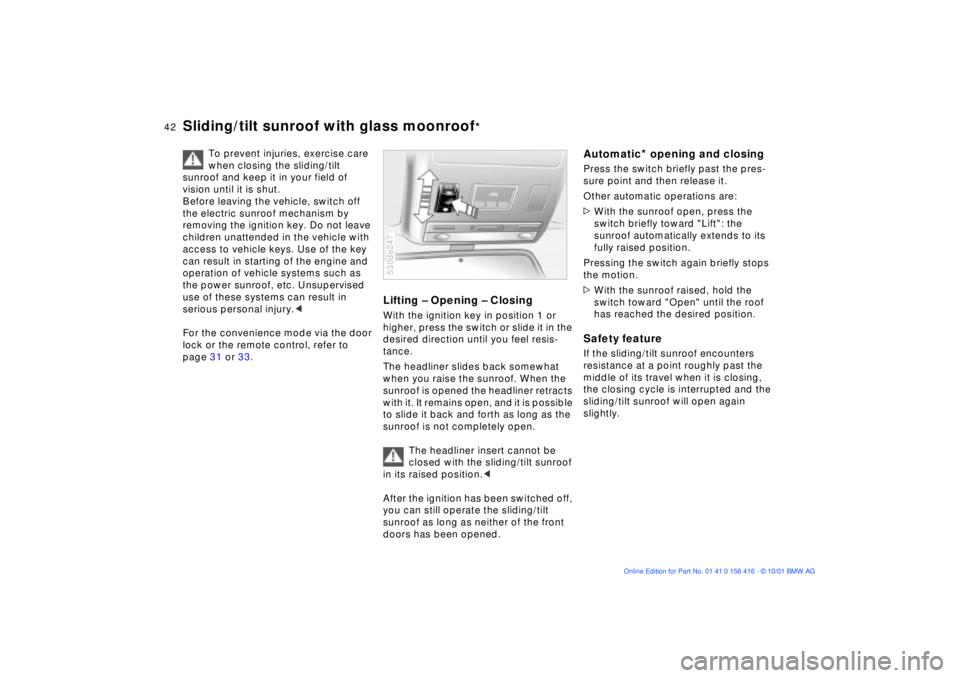
42n
Sliding/tilt sunroof with glass moonroof
*
To prevent injuries, exercise care
when closing the sliding/tilt
sunroof and keep it in your field of
vision until it is shut.
Before leaving the vehicle, switch off
the electric sunroof mechanism by
removing the ignition key. Do not leave
children unattended in the vehicle with
access to vehicle keys. Use of the key
can result in starting of the engine and
operation of vehicle systems such as
the power sunroof, etc. Unsupervised
use of these systems can result in
serious personal injury.<
For the convenience mode via the door
lock or the remote control, refer to
page 31 or 33.
Lifting Ð Opening Ð Closing With the ignition key in position 1 or
higher, press the switch or slide it in the
desired direction until you feel resis-
tance.
The headliner slides back somewhat
when you raise the sunroof. When the
sunroof is opened the headliner retracts
with it. It remains open, and it is possible
to slide it back and forth as long as the
sunroof is not completely open.
The headliner insert cannot be
closed with the sliding/tilt sunroof
in its raised position.<
After the ignition has been switched off,
you can still operate the sliding/tilt
sunroof as long as neither of the front
doors has been opened. 530de247
Automatic
* opening and closing
Press the switch briefly past the pres-
sure point and then release it.
Other automatic operations are:
>With the sunroof open, press the
switch briefly toward "Lift": the
sunroof automatically extends to its
fully raised position.
Pressing the switch again briefly stops
the motion.
>With the sunroof raised, hold the
switch toward "Open" until the roof
has reached the desired position.Safety featureIf the sliding/tilt sunroof encounters
resistance at a point roughly past the
middle of its travel when it is closing,
the closing cycle is interrupted and the
sliding/tilt sunroof will open again
slightly.
Page 59 of 185
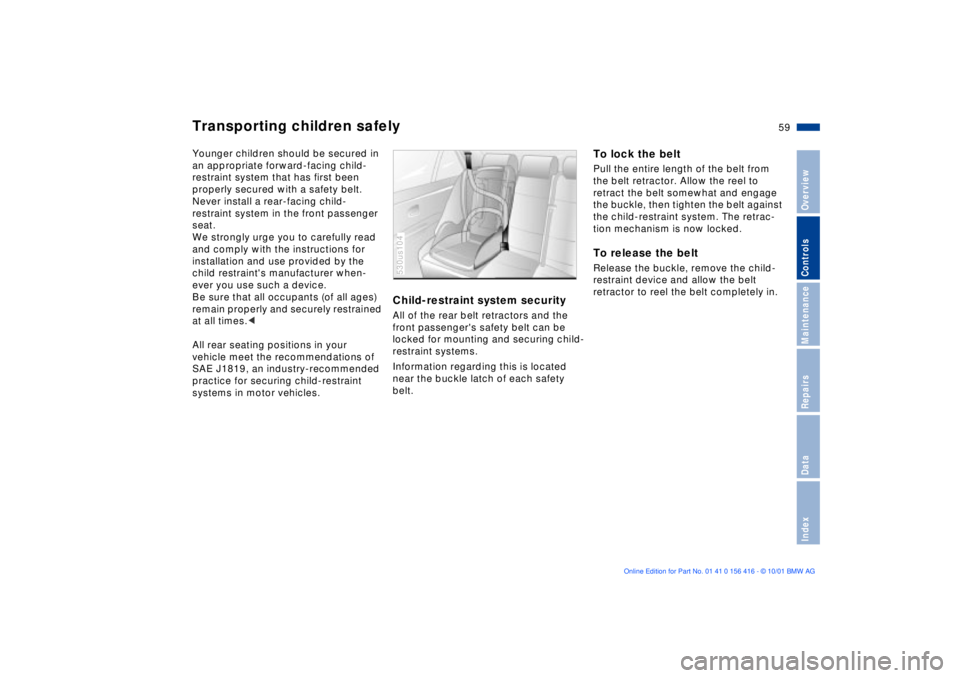
59n
OverviewControlsMaintenanceRepairsDataIndex
Transporting children safelyYounger children should be secured in
an appropriate forward-facing child-
restraint system that has first been
properly secured with a safety belt.
Never install a rear-facing child-
restraint system in the front passenger
seat.
We strongly urge you to carefully read
and comply with the instructions for
installation and use provided by the
child restraint's manufacturer when-
ever you use such a device.
Be sure that all occupants (of all ages)
remain properly and securely restrained
at all times.<
All rear seating positions in your
vehicle meet the recommendations of
SAE J1819, an industry-recommended
practice for securing child-restraint
systems in motor vehicles.
Child-restraint system securityAll of the rear belt retractors and the
front passenger's safety belt can be
locked for mounting and securing child-
restraint systems.
Information regarding this is located
near the buckle latch of each safety
belt. 530us104
To lock the belt Pull the entire length of the belt from
the belt retractor. Allow the reel to
retract the belt somewhat and engage
the buckle, then tighten the belt against
the child-restraint system. The retrac-
tion mechanism is now locked. To release the belt Release the buckle, remove the child-
restraint device and allow the belt
retractor to reel the belt completely in.
Page 60 of 185
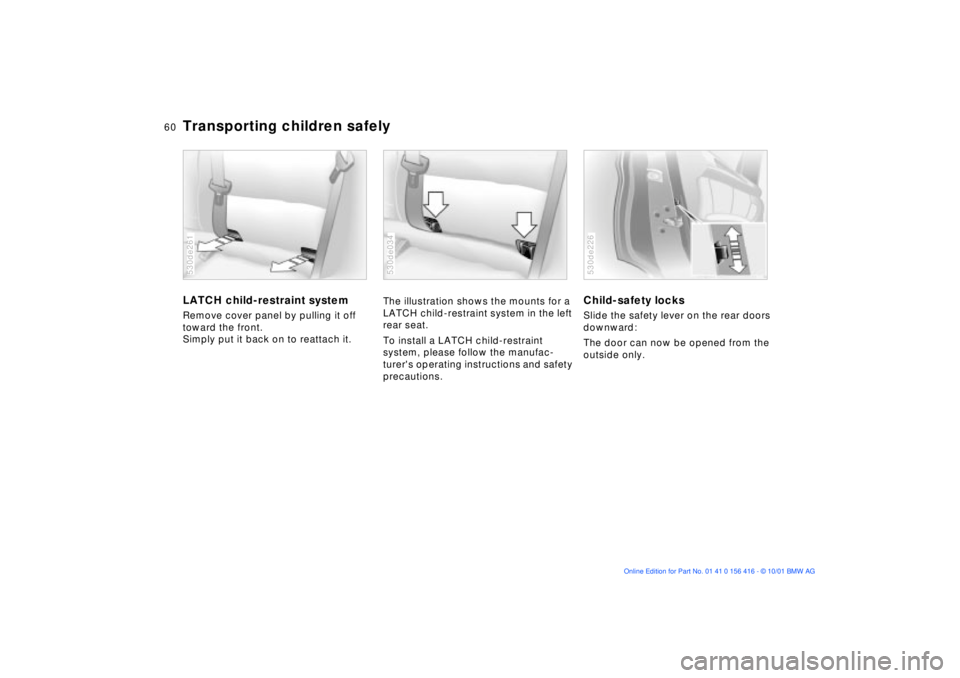
60n
Transporting children safelyLATCH child-restraint systemRemove cover panel by pulling it off
toward the front.
Simply put it back on to reattach it. 530de261
The illustration shows the mounts for a
LATCH child-restraint system in the left
rear seat.
To install a LATCH child-restraint
system, please follow the manufac-
turer's operating instructions and safety
precautions.530de034
Child-safety locksSlide the safety lever on the rear doors
downward:
The door can now be opened from the
outside only. 530de226
Page 145 of 185
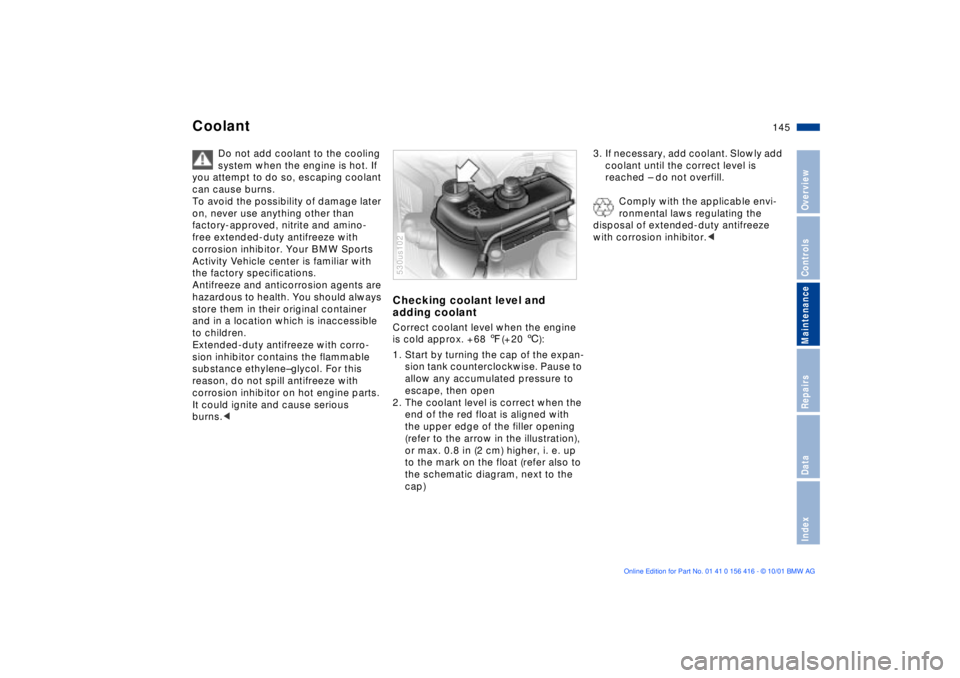
145n
OverviewControlsMaintenanceRepairsDataIndex
Coolant
Do not add coolant to the cooling
system when the engine is hot. If
you attempt to do so, escaping coolant
can cause burns.
To avoid the possibility of damage later
on, never use anything other than
factory-approved, nitrite and amino-
free extended-duty antifreeze with
corrosion inhibitor. Your BMW Sports
Activity Vehicle center is familiar with
the factory specifications.
Antifreeze and anticorrosion agents are
hazardous to health. You should always
store them in their original container
and in a location which is inaccessible
to children.
Extended-duty antifreeze with corro-
sion inhibitor contains the flammable
substance ethyleneÐglycol. For this
reason, do not spill antifreeze with
corrosion inhibitor on hot engine parts.
It could ignite and cause serious
burns.<
Checking coolant level and
adding coolant Correct coolant level when the engine
is cold approx. +68 7(+20 6):
1. Start by turning the cap of the expan-
sion tank counterclockwise. Pause to
allow any accumulated pressure to
escape, then open
2. The coolant level is correct when the
end of the red float is aligned with
the upper edge of the filler opening
(refer to the arrow in the illustration),
or max. 0.8 in (2 cm) higher, i. e. up
to the mark on the float (refer also to
the schematic diagram, next to the
cap)530us102
3. If necessary, add coolant. Slowly add
coolant until the correct level is
reached Ð do not overfill.
Comply with the applicable envi-
ronmental laws regulating the
disposal of extended-duty antifreeze
with corrosion inhibitor.<
Page 177 of 185
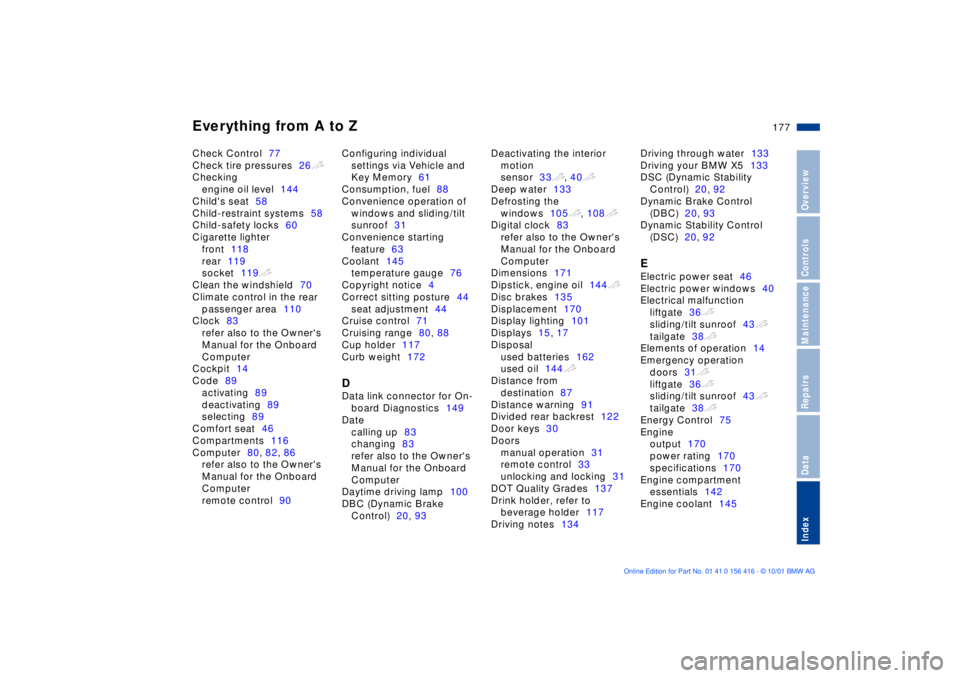
Everything from A to Z
177n
OverviewControlsMaintenanceRepairsDataIndex
Check Control77
Check tire pressures26t
Checking
engine oil level144
Child's seat58
Child-restraint systems58
Child-safety locks60
Cigarette lighter
front118
rear119
socket119t
Clean the windshield70
Climate control in the rear
passenger area110
Clock83
refer also to the Owner's
Manual for the Onboard
Computer
Cockpit14
Code89
activating89
deactivating89
selecting89
Comfort seat46
Compartments116
Computer80, 82, 86
refer also to the Owner's
Manual for the Onboard
Computer
remote control90Configuring individual
settings via Vehicle and
Key Memory61
Consumption, fuel88
Convenience operation of
windows and sliding/tilt
sunroof31
Convenience starting
feature63
Coolant145
temperature gauge76
Copyright notice4
Correct sitting posture44
seat adjustment44
Cruise control71
Cruising range80, 88
Cup holder117
Curb weight172
DData link connector for On-
board Diagnostics149
Date
calling up83
changing83
refer also to the Owner's
Manual for the Onboard
Computer
Daytime driving lamp100
DBC (Dynamic Brake
Control)20, 93Deactivating the interior
motion
sensor33t, 40t
Deep water133
Defrosting the
windows105t, 108t
Digital clock83
refer also to the Owner's
Manual for the Onboard
Computer
Dimensions171
Dipstick, engine oil144t
Disc brakes135
Displacement170
Display lighting101
Displays15, 17
Disposal
used batteries162
used oil144t
Distance from
destination87
Distance warning91
Divided rear backrest122
Door keys30
Doors
manual operation31
remote control33
unlocking and locking31
DOT Quality Grades137
Drink holder, refer to
beverage holder117
Driving notes134Driving through water133
Driving your BMW X5133
DSC (Dynamic Stability
Control)20, 92
Dynamic Brake Control
(DBC)20, 93
Dynamic Stability Control
(DSC)20, 92
EElectric power seat46
Electric power windows40
Electrical malfunction
liftgate36t
sliding/tilt sunroof43t
tailgate38t
Elements of operation14
Emergency operation
doors31t
liftgate36t
sliding/tilt sunroof43t
tailgate38t
Energy Control75
Engine
output170
power rating170
specifications170
Engine compartment
essentials142
Engine coolant145
Page 179 of 185
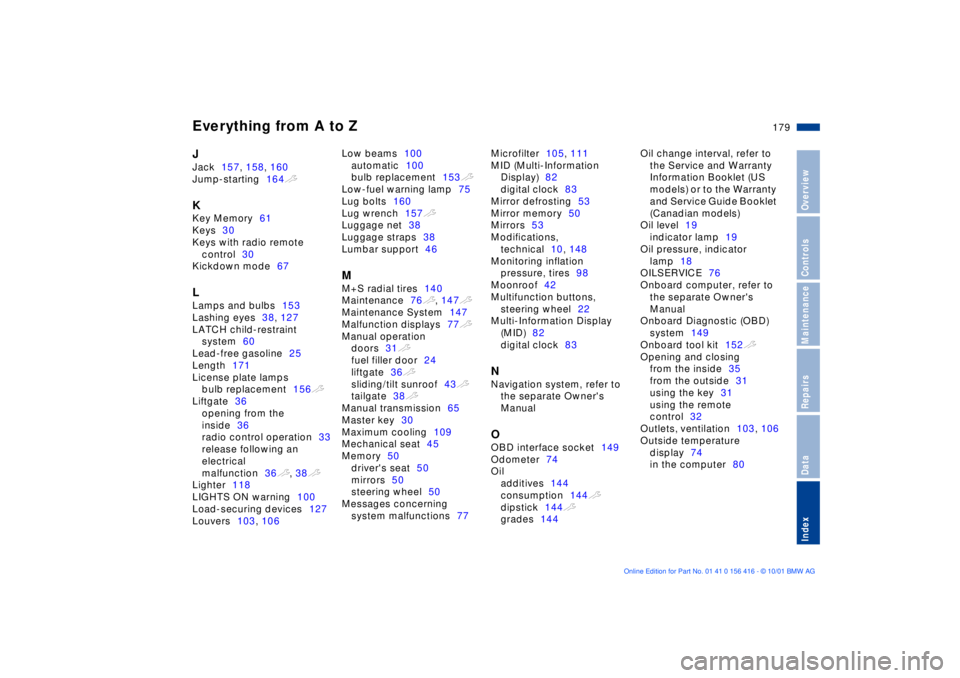
Everything from A to Z
179n
OverviewControlsMaintenanceRepairsDataIndex
JJack157, 158, 160
Jump-starting164tKKey Memory61
Keys30
Keys with radio remote
control30
Kickdown mode67LLamps and bulbs153
Lashing eyes38, 127
LATCH child-restraint
system60
Lead-free gasoline25
Length171
License plate lamps
bulb replacement156t
Liftgate36
opening from the
inside36
radio control operation33
release following an
electrical
malfunction36t, 38t
Lighter118
LIGHTS ON warning100
Load-securing devices127
Louvers103, 106Low beams100
automatic100
bulb replacement153t
Low-fuel warning lamp75
Lug bolts160
Lug wrench157t
Luggage net38
Luggage straps38
Lumbar support46
MM+S radial tires140
Maintenance76t, 147t
Maintenance System147
Malfunction displays77t
Manual operation
doors31t
fuel filler door24
liftgate36t
sliding/tilt sunroof43t
tailgate38t
Manual transmission65
Master key30
Maximum cooling109
Mechanical seat45
Memory50
driver's seat50
mirrors50
steering wheel50
Messages concerning
system malfunctions77Microfilter105, 111
MID (Multi-Information
Display)82
digital clock83
Mirror defrosting53
Mirror memory50
Mirrors53
Modifications,
technical10, 148
Monitoring inflation
pressure, tires98
Moonroof42
Multifunction buttons,
steering wheel22
Multi-Information Display
(MID)82
digital clock83
NNavigation system, refer to
the separate Owner's
ManualOOBD interface socket149
Odometer74
Oil
additives144
consumption144t
dipstick144t
grades144Oil change interval, refer to
the Service and Warranty
Information Booklet (US
models) or to the Warranty
and Service Guide Booklet
(Canadian models)
Oil level19
indicator lamp19
Oil pressure, indicator
lamp18
OILSERVICE76
Onboard computer, refer to
the separate Owner's
Manual
Onboard Diagnostic (OBD)
system149
Onboard tool kit152t
Opening and closing
from the inside35
from the outside31
using the key31
using the remote
control32
Outlets, ventilation103, 106
Outside temperature
display74
in the computer80